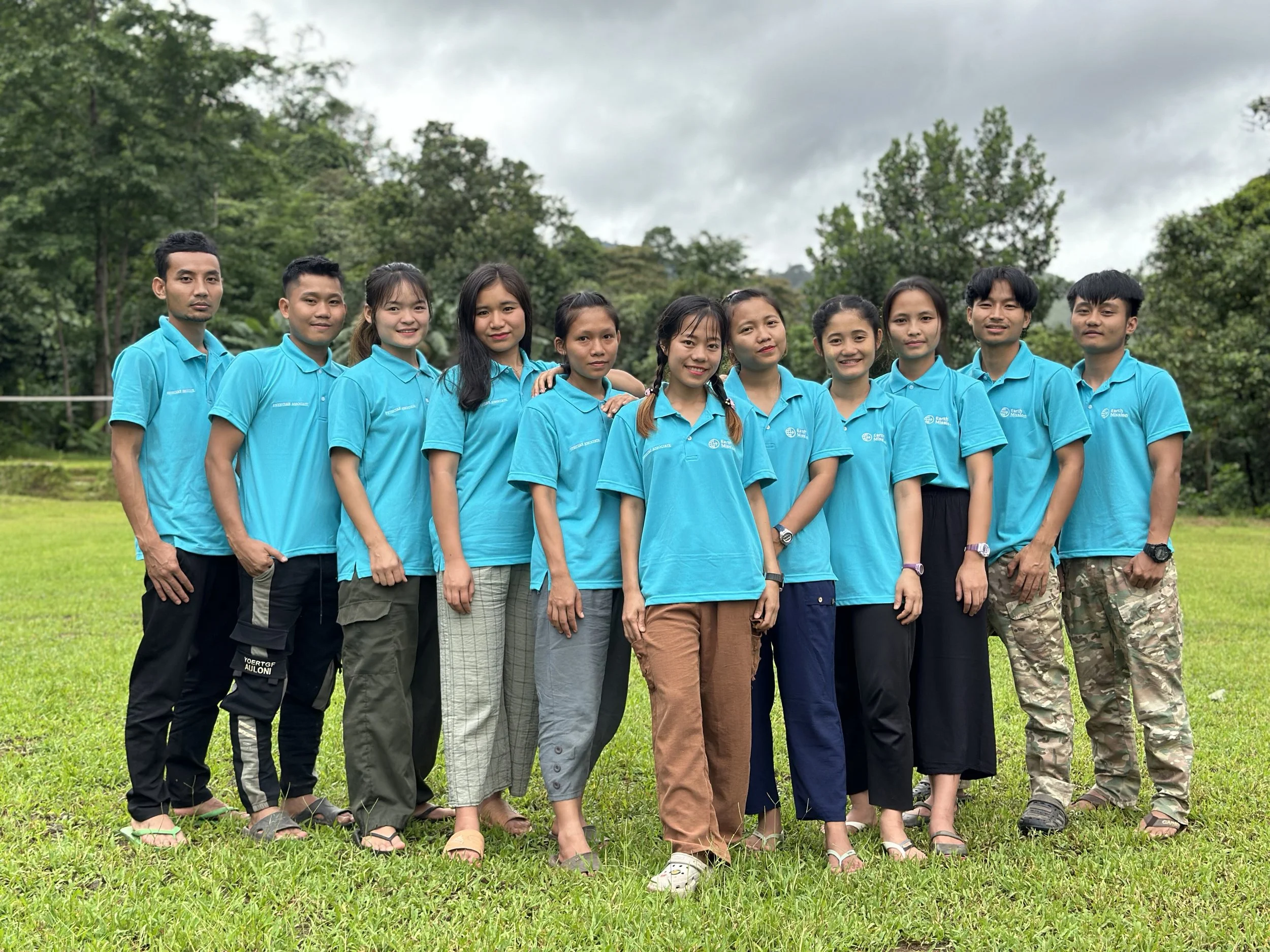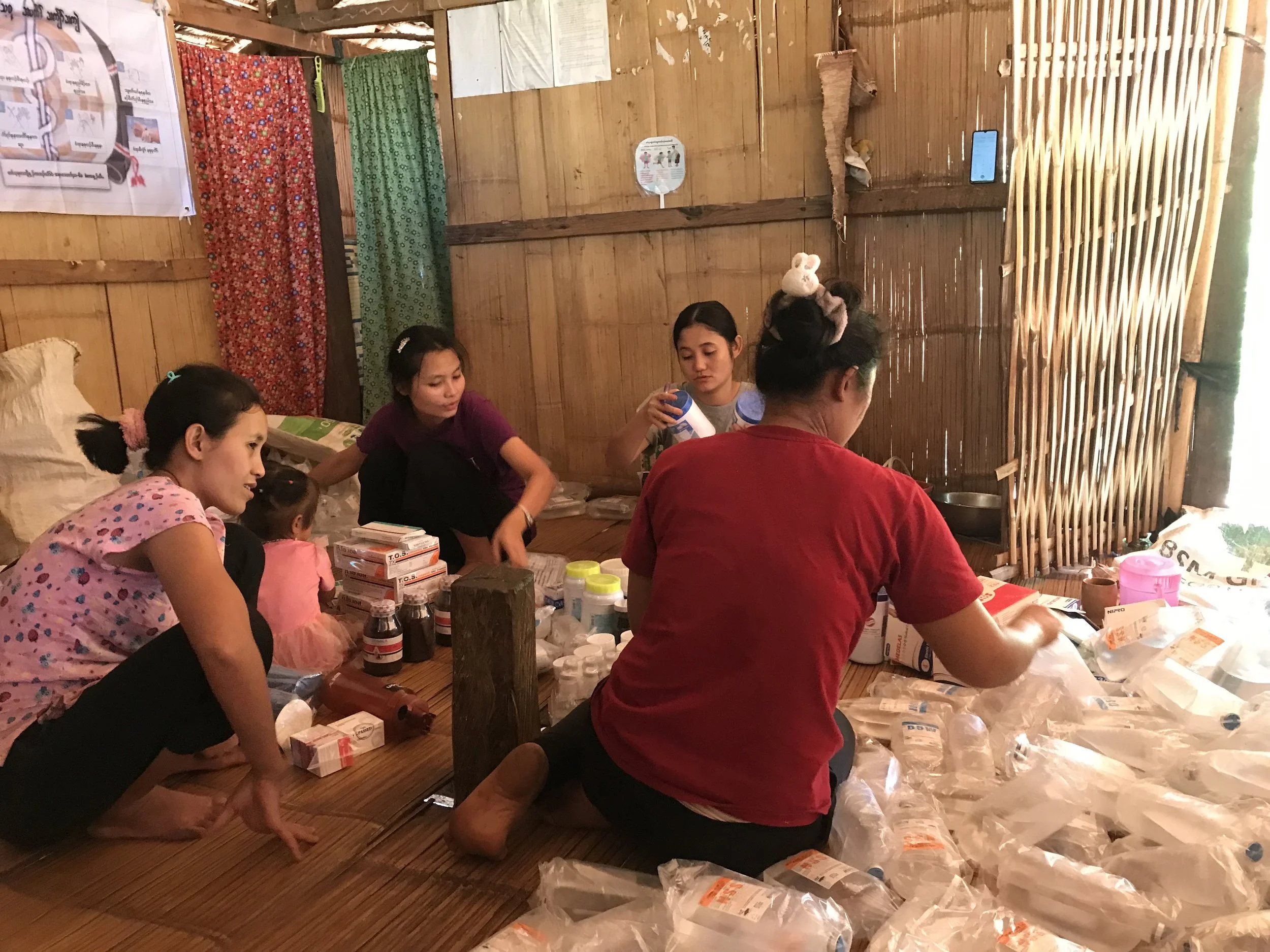“To Them, We Were Heroes.”
Naw Eh Sel Gay (4th from right) and other Year 5 Physician Associate students.
In Year 5, our Physician Associate (PA) students are required to complete 180 internship hours. Placed in rural clinics across Karen State, they apply the knowledge and skills they've gained over four years of training. This six-week experience prepares them to lead and improve remote clinics when they return to their rural communities. This is the incredible internship story of Naw Eh Sel Gay—a student who is improving healthcare for remote Karen regions.
I was placed at Tae Boe Hta Clinic, a small backpack clinic in the mountains, with my classmates Chu Dee Wah and Htoo Gay Paw. After we arrived, we discovered its true situation. The doctors and medics who usually work there had gone to frontline areas near the battles. Only a few community health workers (CHWs) remained. The clinic had not received new medical supplies for over a year, and medicines used to treat common diseases had run out. There were hardly any patients when we first arrived. For a few days, we saw only two patients. But later that week, once people heard that PA students from Rain Tree Clinic (RTC) were interning, we started seeing more than 10 patients a day. People in remote Karen areas know that RTC can treat conditions that most local clinics cannot, so they had high hopes for us.
Most of the clinic’s healthcare workers were married women. Although their medical knowledge was limited, they served with heart and dedication. They asked us to teach them about the most common diseases in their rural area such as malaria, pneumonia, diarrhea, skin infection, womb infestation, and gastritis. So, we held evening classes every weekday. On Wednesdays, we taught public health topics to the clinic staff and villagers. Despite their family responsibilities, these determined women attended every class. Their eagerness to learn was inspiring. It’s not that they can’t treat well—it’s that no one had properly trained them.
Naw Eh Sel Gay (2nd from right) teaches healthcare workers how to categorize medications.
The clinic’s pharmacy area was poorly maintained. The medicines they did have in stock were scattered everywhere, and expired drugs were mixed in with usable ones. Some were not being used simply because the staff didn’t know how. My friends and I called the CHWs into the pharmacy to help us. Together, we categorized medicines like antibiotics, airway medications, and painkillers. We explained their uses and wrote notes for future reference. We threw away expired medicines, which made me sad. Some were expensive and used frequently at RTC.
While walking to a patient’s home one day, I passed a drug shop. I went inside to look. I was surprised to see many kinds of medicine—almost like RTC’s pharmacy. But it made me sad to see them overselling steroid medications to villagers for profit. Steroid overuse can make people unresponsive to appropriate treatments and lead to serious long-term health problems. Because of this, we educated every patient to only buy medicines prescribed by healthcare professionals. Most patients were respectful and obedient, because they trust RTC’s level of care.
I learned that proper training in medical instrument use and maintenance is as important as having the equipment. We were sad when we witnessed the staff performing procedures with non-sterile tools. Some had rusted. We took the instruments to the river. They were scrubbed with sand, washed with soap, and sterilized in an autoclave. We taught the staff how to use and sterilize tools properly. Sterilization is not optional—it is life-saving. Even in low-resource areas, effective sterilization is possible with simple methods. Working with local health workers taught me that teamwork significantly improves both the quality and sustainability of care.
We saw children suffering from parasitic infections, but the clinic didn’t have medication for it. One child came with persistent stomach pain. I initially treated him with antibiotics, but his condition didn’t improve. I reached out to other Year 5 PA interns at a nearby clinic. Thankfully, they had albendazole. After giving the child two doses, he vomited and passed a large number of parasites. We were relieved he felt better. On our next public health education day, we distributed albendazole to villagers—both children and adults—to prevent further infections.
Another lesson I learned was the importance of being ready. At RTC, we relied on our surgeons and instructors. We followed their instructions closely. But now, at our internships in remote areas, we were the most experienced medical professionals. There was no one else to rely on.
One evening, the lights of six motorbikes approached our small hut. The riders came to get my friends and me. Our classmates interning at a nearby clinic needed our help urgently. When we arrived, I was shocked. It was an emergency below-knee amputation. The patient had been wounded in battle and couldn’t be referred to a larger hospital because of the long and mountainous roads. If he traveled by “bambulance” (a hammock hung on a bamboo pole carried by strong people), it might have been too late to save him.
The villagers watched us with hope in their eyes. They believed we could save his life. For the past four years, we have observed, assisted, and performed surgeries under the guidance of our teaching doctors and nurses. However, we had never performed a surgery on our own before. But we didn’t show our fear. We acted confident for the sake of those watching us.
Dah Boy, our classmate who called us, took the role of lead surgeon. He asked me to be the instrument nurse. Htoo Gay Paw served as the anesthesiologist. Chu Dee Wah was the second assistant, and Hay Blut Soe supported Dah Boy directly.
We were a team of five.
We began the surgery with very limited instruments. I reminded my team from time to time to limit use of Vicryl, gauze, and other essential tools so we wouldn’t run out. The operation took nearly three hours. By God’s grace, it was successful. After the surgery, we all sighed with relief. I was so proud of my team. In a place with no emergency care options, we were able to save a life. It was already nighttime when we finished, and there was no water to wash off the blood. We had to sleep like that. The next morning, we climbed down to the river to clean ourselves.
The villagers sent us off with baskets full of fresh fruits and vegetables. Every face wore a smile. To them, we were heroes. One person said, “You truly are life-saving medical professionals.” Seeing their gratitude and joy filled my heart with happiness.
It was a moment I’ll never forget.
Sponsor Ei Thazin
You can make more stories like this possible. With a suggested gift of $1,000 annually or $150 monthly, you can provide an entire year of life-saving education for an EM student.
Today, 18% of students are sponsored—thank you to our 48 current sponsors! With our EM family’s help, we want to see a student sponsored every month. Meet July’s featured student:
Ei Thazin, Year 4 Physician Associate Student
“One thing that really motivates me is hearing stories from our Year 5 seniors about their internships. In remote areas, internship is different—it means training local clinic workers. Our teaching hospital is the only well-equipped medical center in this large region. When our seniors shared how they faced difficult cases and made decisions themselves, I felt inspired. I’ve been studying hard, especially neurology topics like stroke, heart attack, and ischemia, because they are complicated cases we often see at RTC. They require a deep understanding. I want to be ready.”
From individuals to families, from churches to foundations, and even crowd-funding in memory of a loved one—there are many ways your community can champion these young men and women who are their country’s future.








